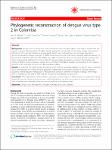Phylogenetic reconstruction of dengue virus type 2 in Colombia
Méndez, Jairo A.
Usme-Ciro, José A.
Domingo, Cristina
Rey, Gloria J.
Sánchez, Juan A.
Tenorio, Antonio
Gallego-Gomez, Juan C.
Background: Dengue fever is perhaps the most important viral re-emergent disease especially in tropical and subtropical countries, affecting about 50 million people around the world yearly. In Colombia, dengue virus was first detected in 1971 and still remains as a major public health issue. Although four viral serotypes have been recurrently identified, dengue virus type 2 (DENV-2) has been involved in the most important outbreaks during the last 20 years, including 2010 when the fatality rate highly increased. As there are no major studies reviewing virus origin and genotype distribution in this country, the present study attempts to reconstruct the phylogenetic history of DENV-2 using a sequence analysis from a 224 bp PCR-amplified product corresponding to the carboxyl terminus of the envelope (E) gene from 48 Colombian isolates. Results: As expected, the oldest isolates belonged to the American genotype (subtype V), but the strains collected since 1990 represent the American/Asian genotype (subtype IIIb) as previously reported in different American countries. Interestingly, the introduction of this genotype coincides with the first report of dengue hemorrhagic fever in Colombia at the end of 1989 and the increase of cases during the next years. Conclusion: After replacement of the American genotype, several lineages of American/Asian subtype have rapidly spread all over the country evolving in new clades. Nevertheless, the direct association of these new variants in the raise of lethality rate observed during the last outbreak has to be demonstrated.
Dateien zu dieser Publikation
Keine Lizenzangabe

